|
History in
a Pecan Shell
Stockton P. Donley was a Texas Supreme Court Judge.
Clarendon has nearly as interesting a founding as Post,
Texas. While Post was founded on matters of health, so was Clarendon
- in a way. It was originally set up to be a town where cowboys could
"dry out". L. H. Carhart, a Methodist Minister, envisioned Clarendon
to be what he called a "sobriety settlement." |
Clarendon
1890 City Map
Click on image to enlarge
Photo courtesy Wikimedia Commons |
History of
Clarendon
by Lou Ann Herda
"If you're like me, when you hear the name Texas
Panhandle, you probably think blue northers and the Palo
Duro Canyon. It gets cold, cold in the Panhandle
where there's hardly anything but barbed
wire fence to keep out the brisk Arctic wind in the winter.
Donley County is one of the squared counties located in the Panhandle.
Formerly the domain of Plains Apaches and later the Comanches and
Kiowas, this region was once overrun with buffalo
until White men settled in the latter 1870s. Many battles ensued between
the tribes and the Whites, including the decisive Red River War of
1874-75. Thereafter, the Indians were put on reservations in Indian
Territory, and the buffalo
were slaughtered. With the buffalo
gone, vast cattle ranches
could be established.
This is about when Methodist preacher Lewis Carhart established "Saints
Roost" up in those parts. Actually, Carhart called his no-liquor,
no-gambling Christian colony "Clarendon" after his wife, Clara. But
local rowdies gave it its nickname since they weren't allowed to be
rowdy there. Carhart's motto, "Christianity, Education, Temperance,
Civilization - Westward," set high expectations for the townspeople.
Nevertheless, a saloon and dance hall were going to be erected by
some outsiders at one point. This didn't set well with several local
cowboys, who offered to scalp them if they didn't leave. It took legendary
cattle driver Charles
Goodnight to persuade the business owners to pack up and leave.
He gave them ten hours to go, and, by golly, they were gone before
that. By the early 1880s, Clarendon
was one of only three towns in the Panhandle.
Saints Roost is now like Atlantis, under water (the Greenbelt Reservoir,
to be exact). Clarendon has been
the county seat since 1882.
Incidentally, the August 2, 1879, edition of the Clarendon News,
which claimed that there was to be "no whisky forever in Clarendon,"
made comment on the Sunday law. This so-called law extended between
the hours of midnight on Saturday until midnight on Sunday, during
which time no shopping or trading was allowed. It appears that a drought
had laid siege on the land and that "to many old guzzlers, it seem[ed]
an eternity between drinks." I guess they were guzzling lemonade since
whisky wasn't allowed."... more
From "Donley
County Courthouse" |
Clarendon,
Texas
Attractions / Landmarks
|
| Photo
courtesy Rhonda Aveni |
Donley
County Courthouse -
The 1894 courthouse restored to its former glory.
Saints
Roost Museum -
Hwy 70 South of town. In former Hospital founded by Cornelia Adair.
The name Saint's Roost was bestowed upon Clarendon by cowboys who
were mildly chiding the founder's intentions.
Clarendon
Hotels Book Here
|
S.W.
Lowe House
National Register of Historic Places
Recorded Texas Historic Landmark |
St.
John Baptist Episcopal Church
Oldest church continuously in use in the Texas Panhandle
Recorded Texas Historic Landmark
On 3rd & Parks Street
Photo courtesy Barclay
Gibson, July 2009 |
Historical Marker:
At intersection of 3rd & Parks, Clarendon
Church of Saint John Baptist
Oldest church continuously in use (in earliest Episcopal parish) in
the Texas Panhandle.
The first services were held by the Rev. Mr. Townsend of Dallas Diocese
in the J. B. McClelland Ranch house, Nov. 1877. On site given 1891
by Isaac W. Carhart, building was erected in 1893. A donor, Mrs. Elizabeth
Goff of Philadelphia, chose the name. The church was consecrated April
24, 1893, by Bishop A. C. Garrett. First Vicar: the Rev. W. D. Sartwell,
1890-93.
Recorded Texas Historic Landmark-1971 |
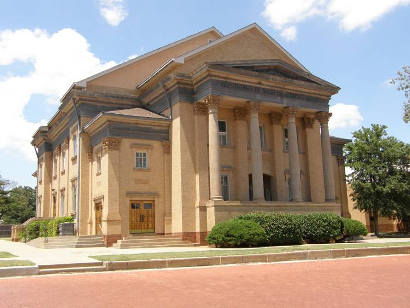 |
Historical Marker:
420 S. Jefferson Street
First United Methodist Church of Clarendon
When the Rev. Lewis H. Carhart, a Methodist minister, founded Clarendon,
he envisioned it as a religious and educational center. The town was
established in 1878 near the junction of Carroll Creek and the Salt
Fork of the Red River, six miles north of its present location. Local
cowboys nicknamed the settlement "Saint's Roost" because it had no
saloons. The first building erected was a combination church and school.
Until the turn-of-the-century, there was a Northern Methodist Church
in the community. When the railroad arrived in 1887, Clarendon moved
to its present site. The Rev. James T. Hosmer, a circuit rider, conducted
Methodist services in private homes. In 1888 the Rev. Isaac L. Mills
and 15 charter members organized the Methodist Episcopal Church, South.
In 1890 the fellowship erected a frame church building on the southeast
corner of Kearney and 4th Street. Membership increased significantly
after the founding in 1898 of Clarendon Methodist College, forerunner
of Clarendon Junior College. To accommodate the growing congregation,
this large classical revival structure was built in 1910, during the
pastorate of the Rev. O. P. Kiker. The original roof was replaced
in 1950.
(1978) |
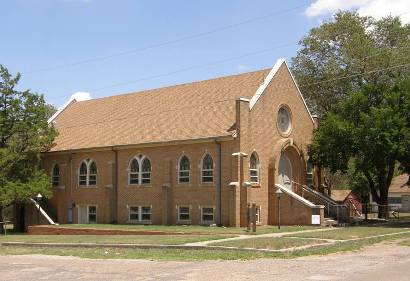 |
1936 Texas Centennial
marker: From Clarendon, take Hwy 70 about 1 mile south to Citizens'
Cemetery
Clarendon
Cemetery
In this first cemetery
of Donley County,
sixteen rods west lie the first dead of Old Clarendon. Here white
civilization sank its roots in sadness and from the graves in this
sacred acre strong pioneer spirits turned to face the future with
greater love for the land and a firmer determination to build for
a tomorrow which we know today. To those of the Old Clarendon Colony
who first found rest on this bold promontory and to their survivors,
this stone of imperishable Texas granite is loyally and lovingly dedicated.
Erected by the State of Texas, July 4, 1938 |
Historical Marker:
16.5 miles N of Clarendon on Hwy 70 right-of-way, near intersection
with CR B
Jericho Cemetery
(1 mile west)
Settlement of this area of Donley
County began in the late 19th century, before the town of Jericho
was founded as a station on the Chicago, Rock Island and Gulf rail
line about 1902. Early community burials took place in the pasture
near this site, and the graveyard eventually was set aside in the
county deed records. The first documented burial is that of Mattie
Ray (1850-1895), and the second is that of seven-month-old Garil Prest
Schaffer, who died in 1897. Others buried in the Jericho Cemetery
include victims of smallpox and influenza epidemics, military veterans
and area pioneers.
(2001) |
Claredon, Texas
Old Photos
|
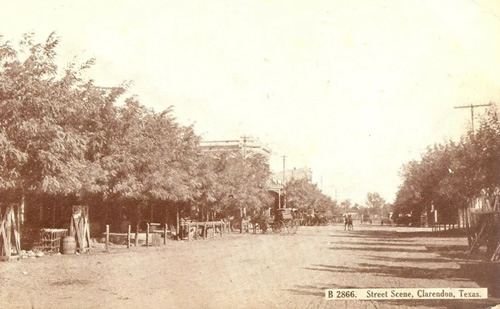 |
|
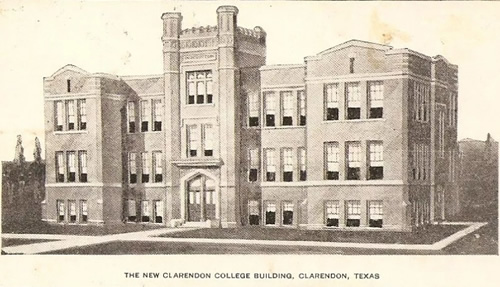
|
Historical Marker:
1122 College Drive
Clarendon College
On April 2, 1898, the first college in the Texas
Panhandle, Clarendon College and University Training School (Clarendon
College), was organized by the Methodist Church Conference. The college’s
doors opened in the town of Clarendon on September 5, 1898, and for
the first few years, courses were offered for students ranging from
first grade through college. The college graduated its first class
in 1904. On February 21, 1903, the Clarendon College bulldogs played
one of the earliest football games ever held in the Texas
Panhandle, beating the Goodnight College Buffaloes 16-10. Dr.
George S. Slover oversaw an expansive period as president and led
Clarendon to become a senior college on September 14, 1926. Clarendon
conferred 28 bachelor’s degrees before returning to junior college
status and coming under the direction of the Clarendon School District
in 1927. Under President Kenneth D. Vaughan, the college separated
from the public school and a county-wide college district was formed
in 1965. An endowment from Sisters Etta and Ida Harned allowed the
college to move from its historic location and build the modern campus
in 1968. Clarendon College opened its first satellite center in Pampa
in 1978 and later opened centers in Childress
and Amarillo.
Clarendon College remains a cultural center of Donley County and the
region and continues to provide students in its service area an opportunity
for higher education.
2015 |
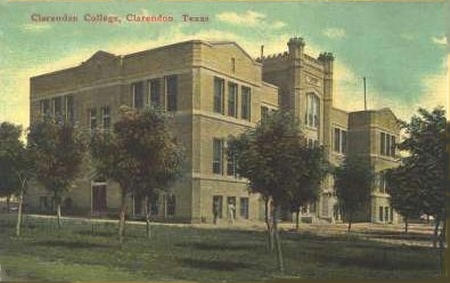 |
Clarendon College
1913 postcard courtesy www.rootsweb.com/ %7Etxpstcrd/ |
|
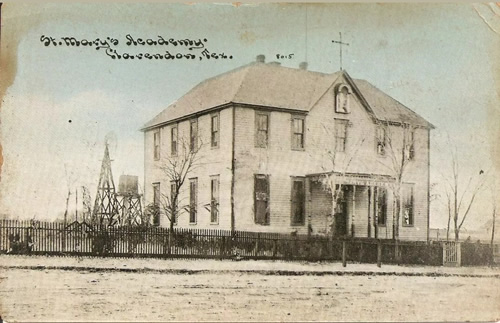
|
| People:
From Titanic
Texans by Mike Cox
"Two former
Texans also died in the infamous disaster -- James H. Bracken and
Alfred Rowe. Bracken had lived for a time near Bend,
a small town on the Colorado River in San
Saba County. Rowe owned a large ranch near Clarendon
in Donley County.
Bracken, born in Kentucky in 1881, gained his Texas connection in
marrying San Saba
county native Addie Greathouse in 1907. Later they moved from
Bend to New Mexico, and
it was from there that he left for England on a cattle-buying trip.
On his way home as a second-class passenger when the ship sank,
his body was never identified.
In the late 1870s, British citizen Rowe, born in Peru in 1853, bought
a ranch in the Panhandle
and spent most of his time in Texas until the early 1900s. In 1910,
he moved back to Kensington, England but still made business trips
back to his ranch. He was traveling as a first-class passenger when
the ship went down. His body was recovered and his remains were
shipped to England for burial."
(See full article)
|
Clarendon
Tourist Information
Clarendon/Donley
County Chamber of Commerce
PO BOX 730 Clarendon, Texas 79226
806-874-2421
www.clarendonedc.org |
Subject:
Clarendon, Texas Historical Places
Adair Hospital
It was erected by Mrs. C. Adair on the ranch to treat the hired
hands of the ranch. Till then there was no other hospital for treatment.
It stayed in operation till 1970's when the new county hospital
was built going out of town by the drive in. Till then it was the
county hospital for a extremely long time. Till the new hospital
was built unless you were born at home you were born in that hospital.
I was born in 1960. My mother was the Office Manager at that time.
Having adolescent asthma meant I spent a lot of time there.
The pipe organ in the Baptist Church
At one time it was the largest pipe organ in N. Texas. It had been
painted with native flowers and butterflies. It was a thing of beauty.
Why they decided to paint it over I don't know. There was a painting
Mary done by a local artist that they discovered kind of glowed
in the dark. It wasn't supernatural. It had to do with the combination
of items used in the crafting of it. It was moved down to the children's
area in the basement for a long time. The metal rings embedded in
the curb were for people to tie their horses to during meetings.
(There are fewer and fewer of these each year.)
The first and longest operating drug store was in Clarendon.
Not only the first but last legal hanging was in Clarendon.
The man was innocent. They found out afterwards that another man
had done it. Side note: The youngest deputy involved in it never
got over it. He would sit in his rocking chair saying "He didn't
do it" over and over.
Clarendon is the only cowboy cemetery still in operation.
There is so much more to my hometown to be proud of.
- Gwen Edgett, June 05, 2016
|
Subject:
Clarendon History
Dear Editor - I am doing some genealogical history and am wondering
if you have suggestions as to a local person with whom I might communicate.
I am researching a fellow named Rev. Richard Allen Hall who was
a minister in the Methodist Episcopal Church, South. He was Presiding
Elder of the Clarendon District for four years in the 1893-1899
period. Supposedly he helped to found or did found Clarendon College
and was on the Board of Trustees. He married a woman named Alice
Texanna Neely from that area in 1881. If you have any suggestions
as to someone who might be familiar with area Methodist preachers
in that period or the founding of Clarendon, I would be very interested
in communicating with them. Thank you. - Kalmin Smith, May 28, 2006,
KalminSmith@aol.com
|
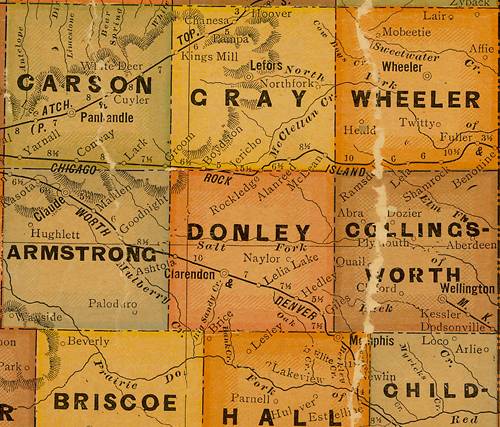 |
| Texas
Escapes, in its purpose to preserve historic, endangered and vanishing
Texas, asks that anyone wishing to share their local history, stories,
landmarks and recent or vintage photos, please contact
us. |
|
|
